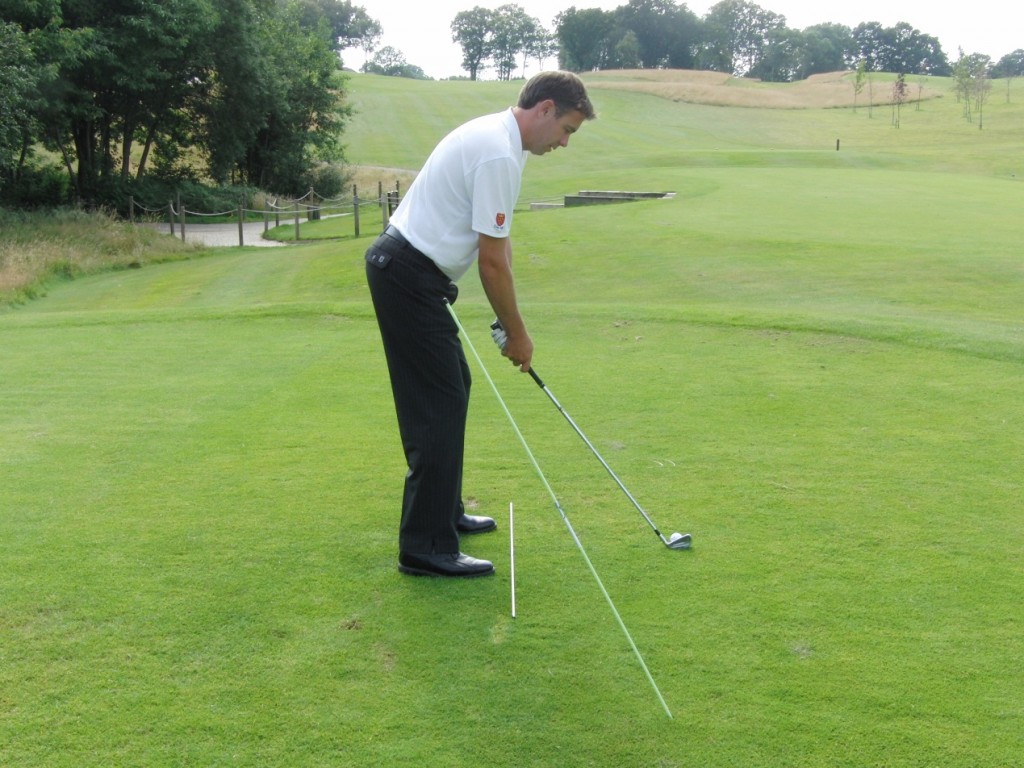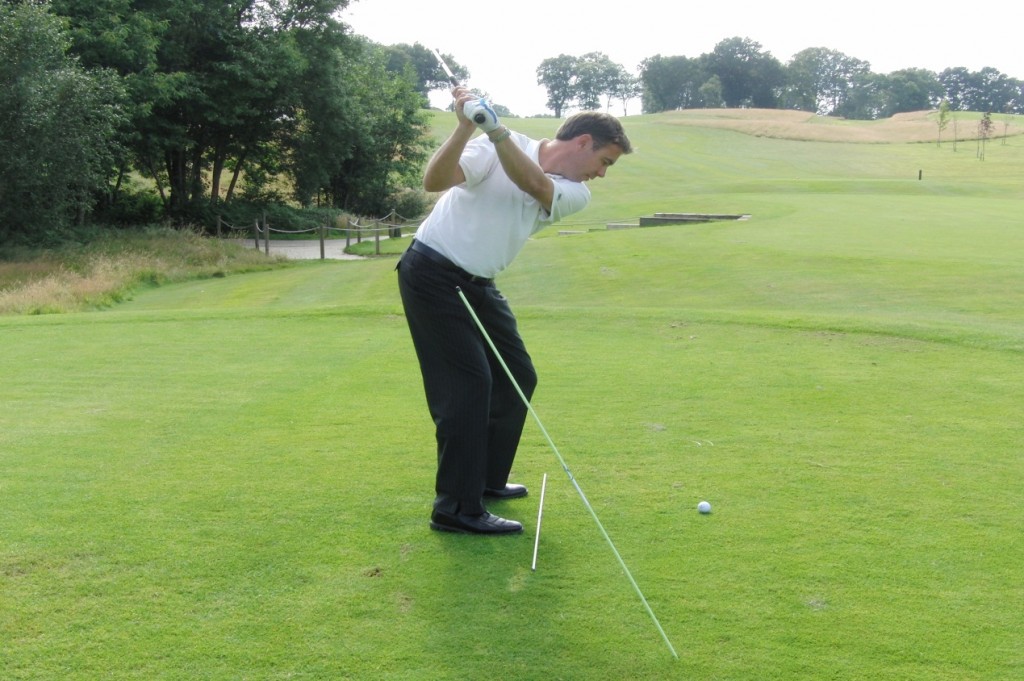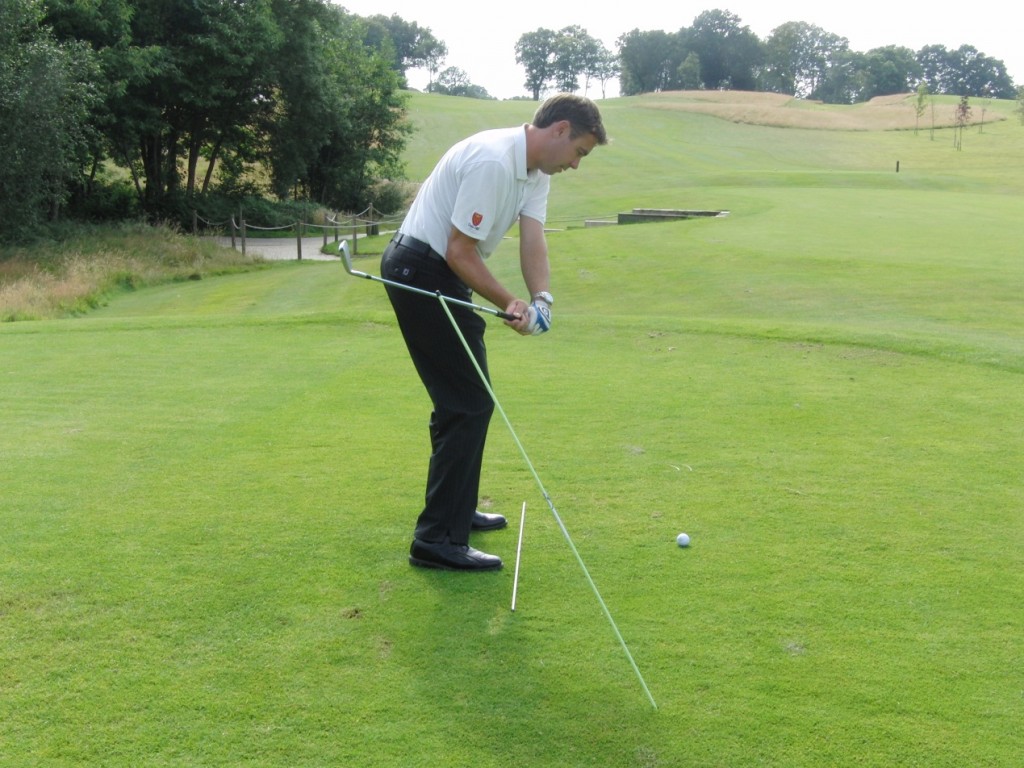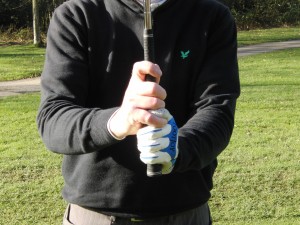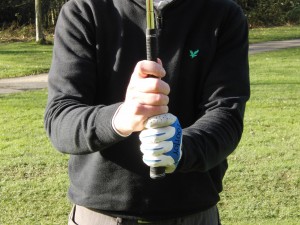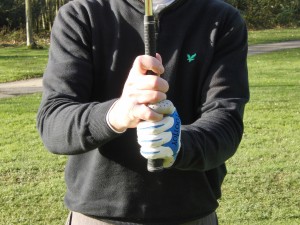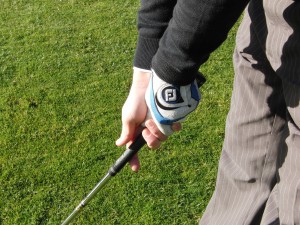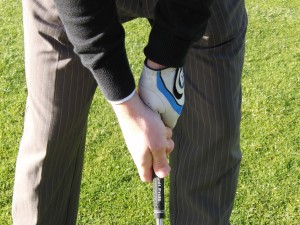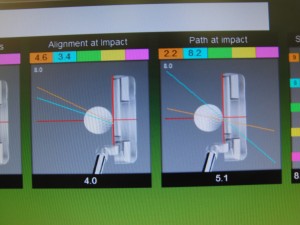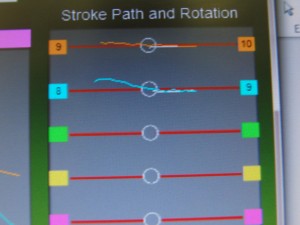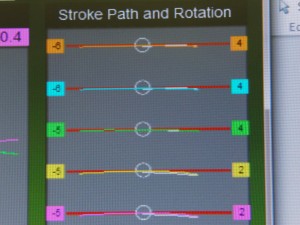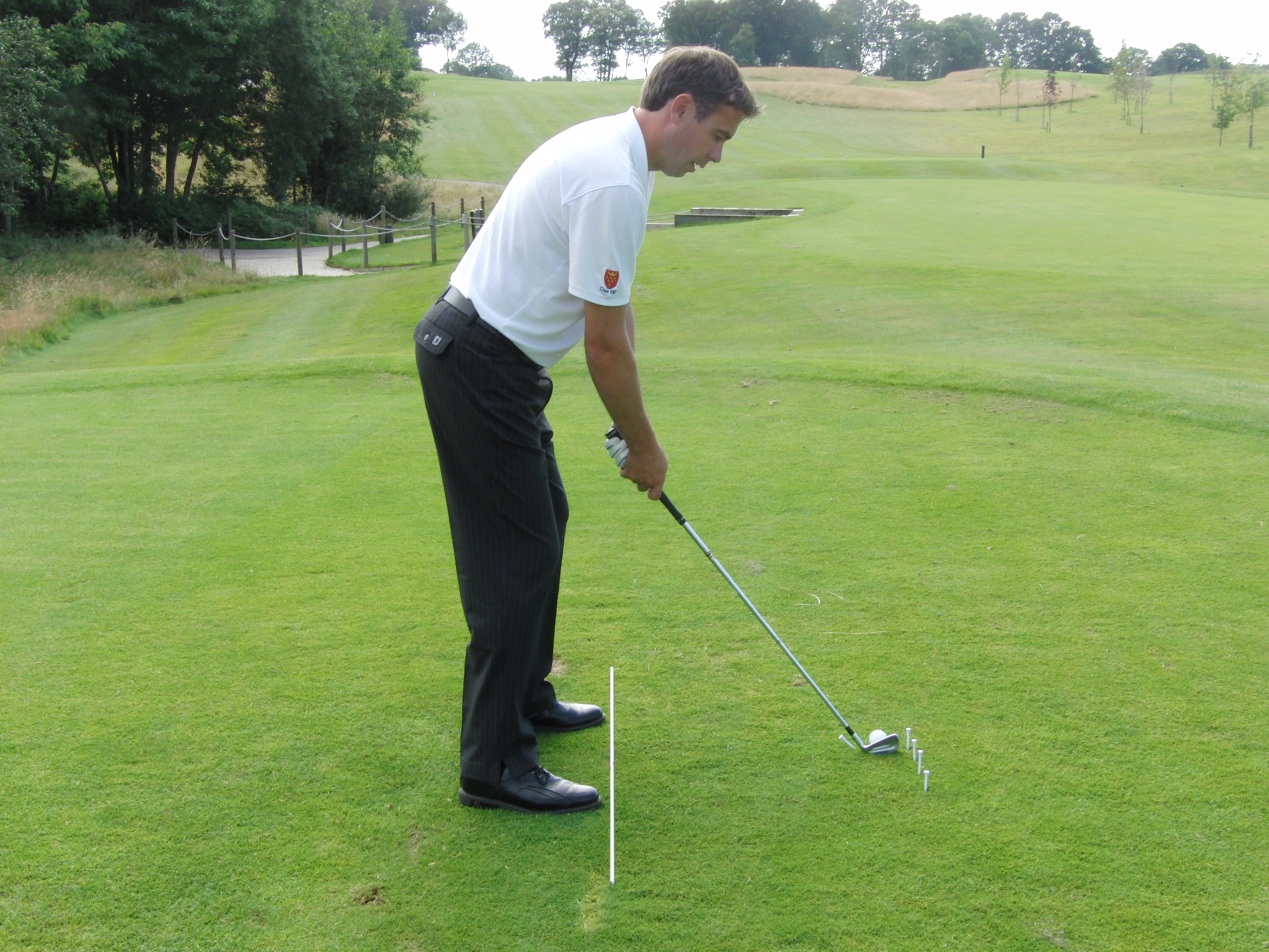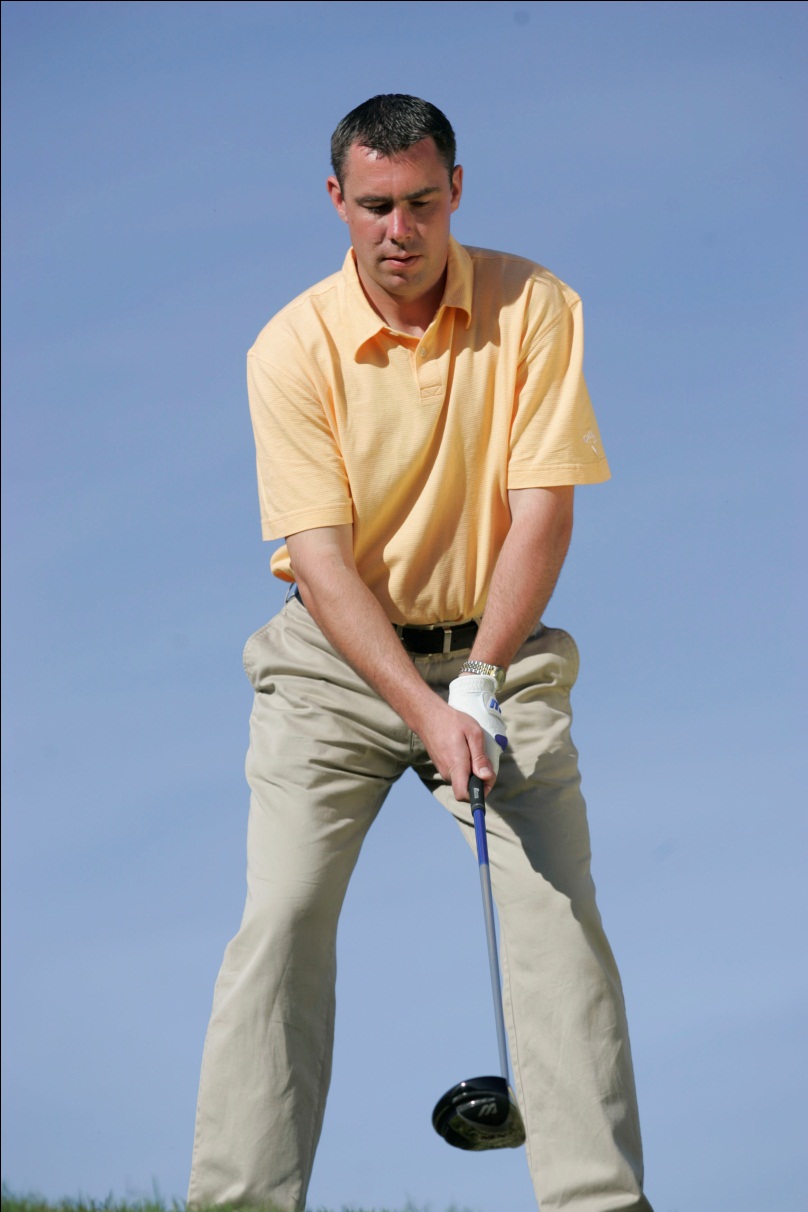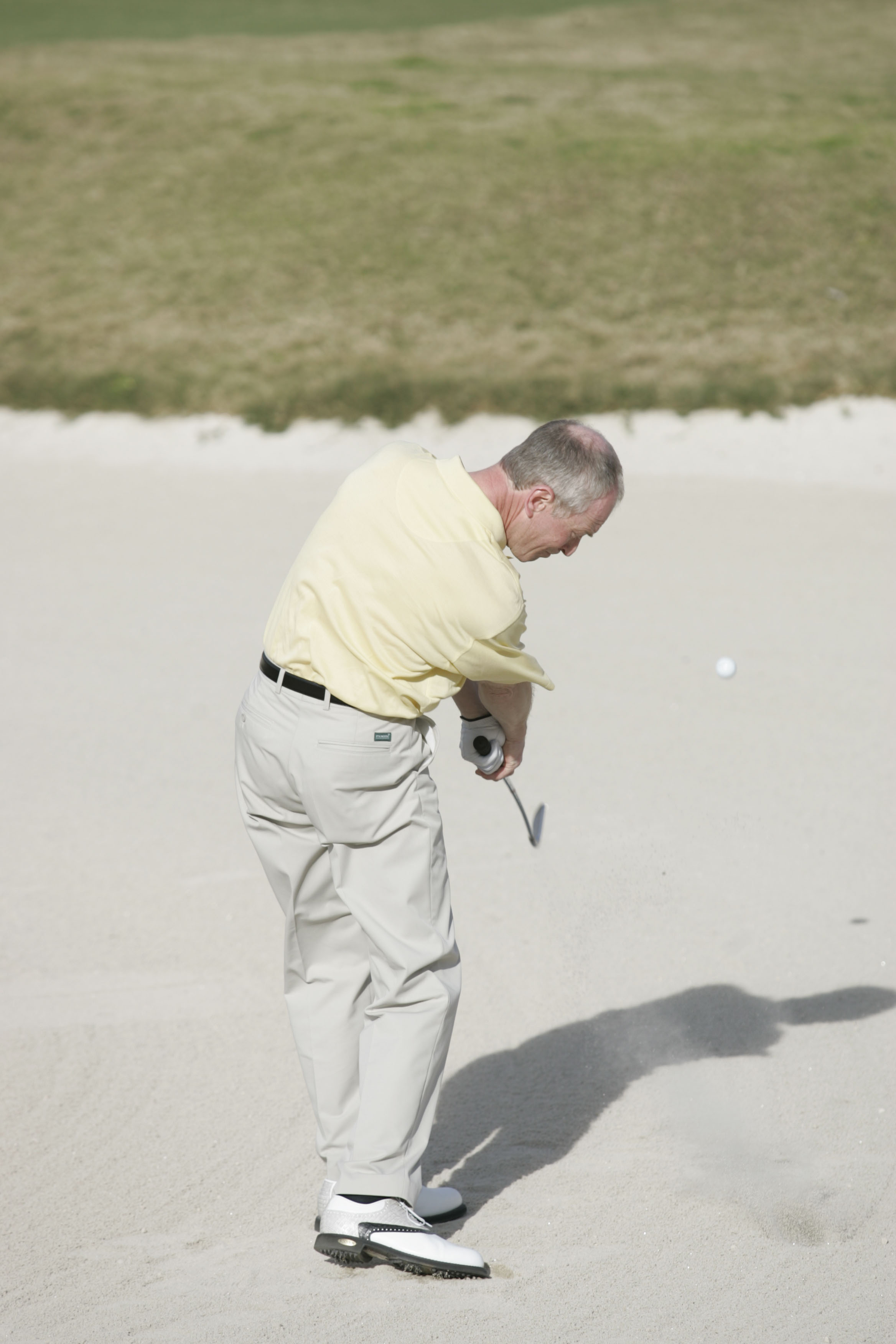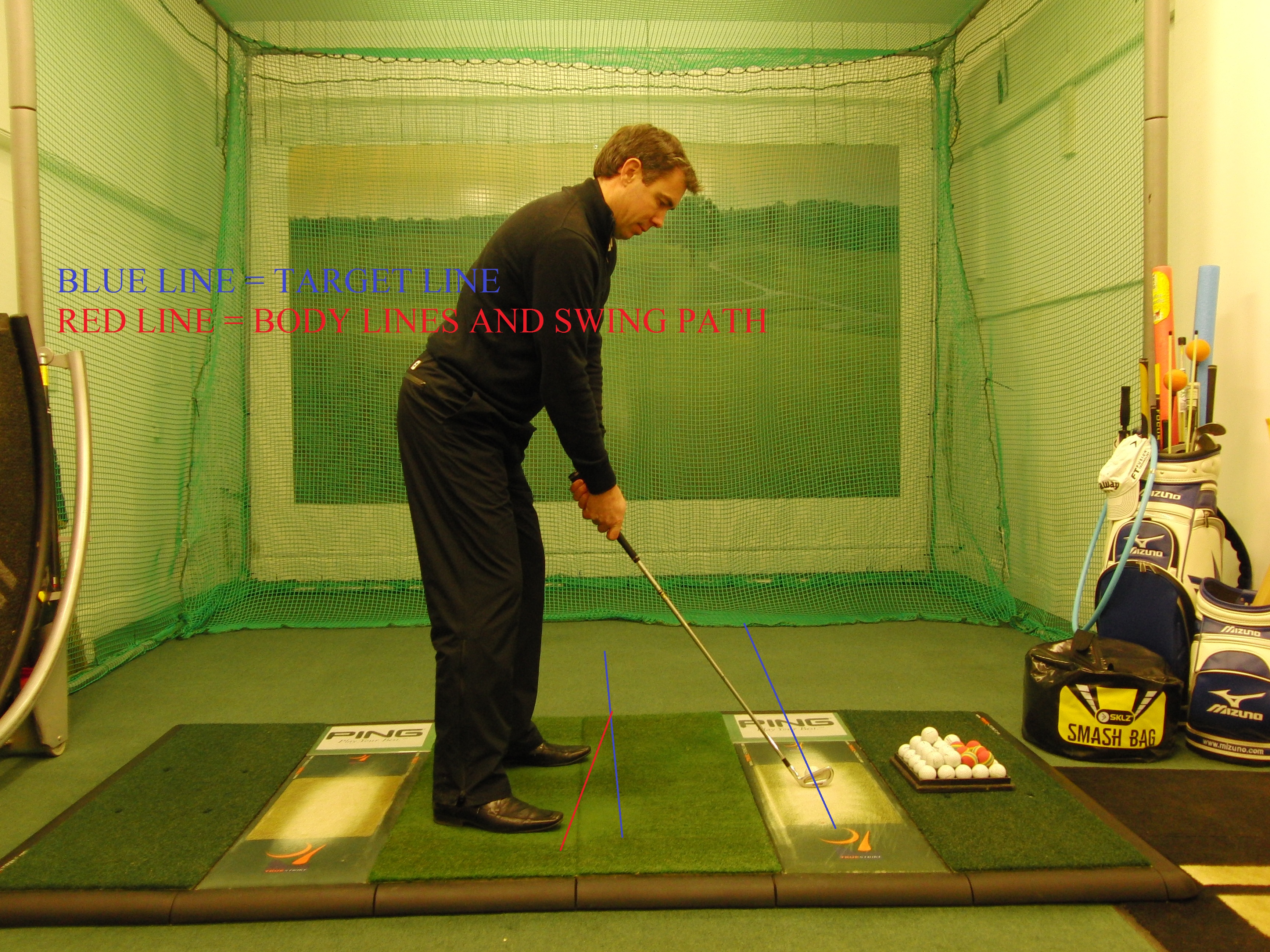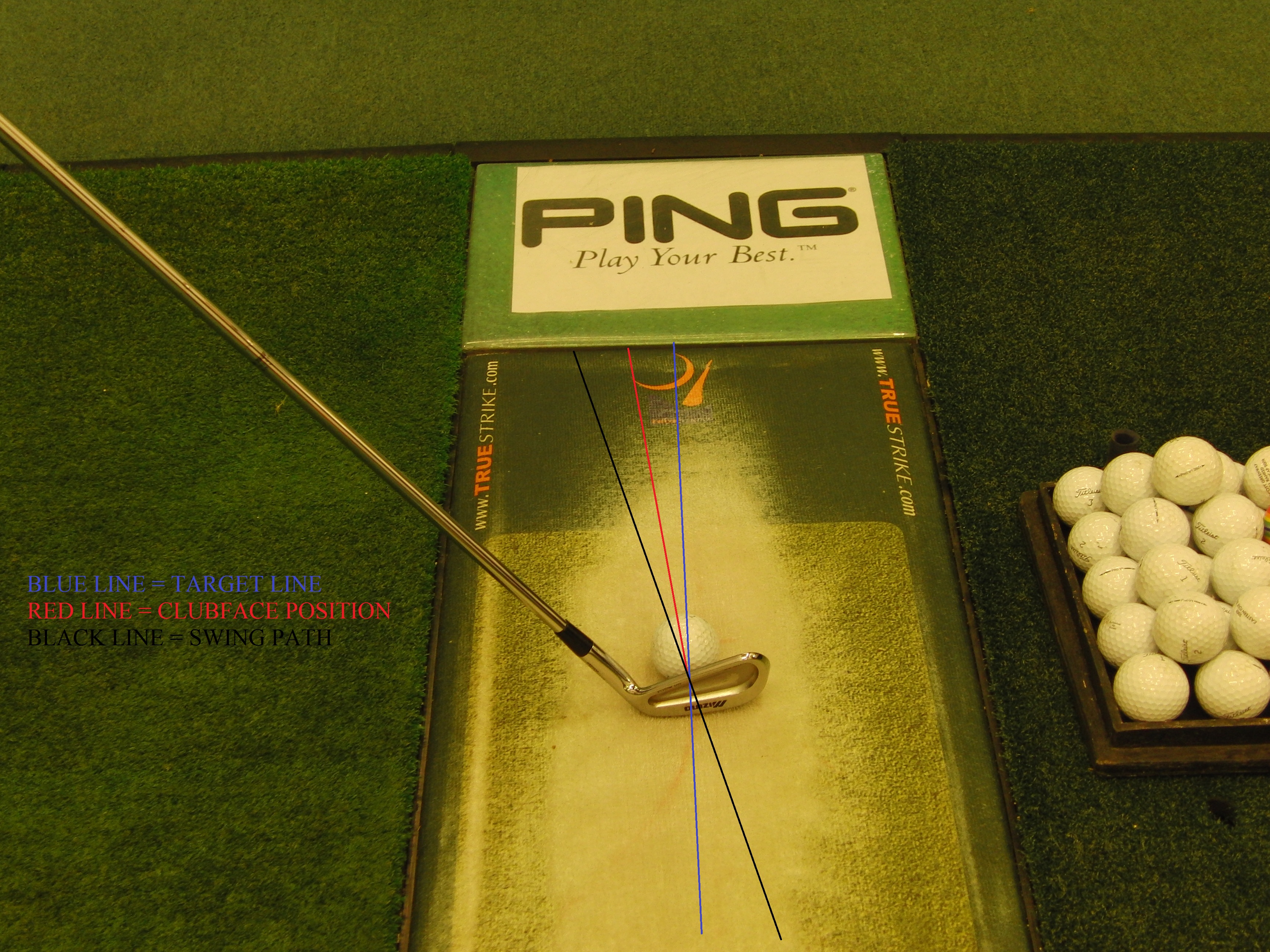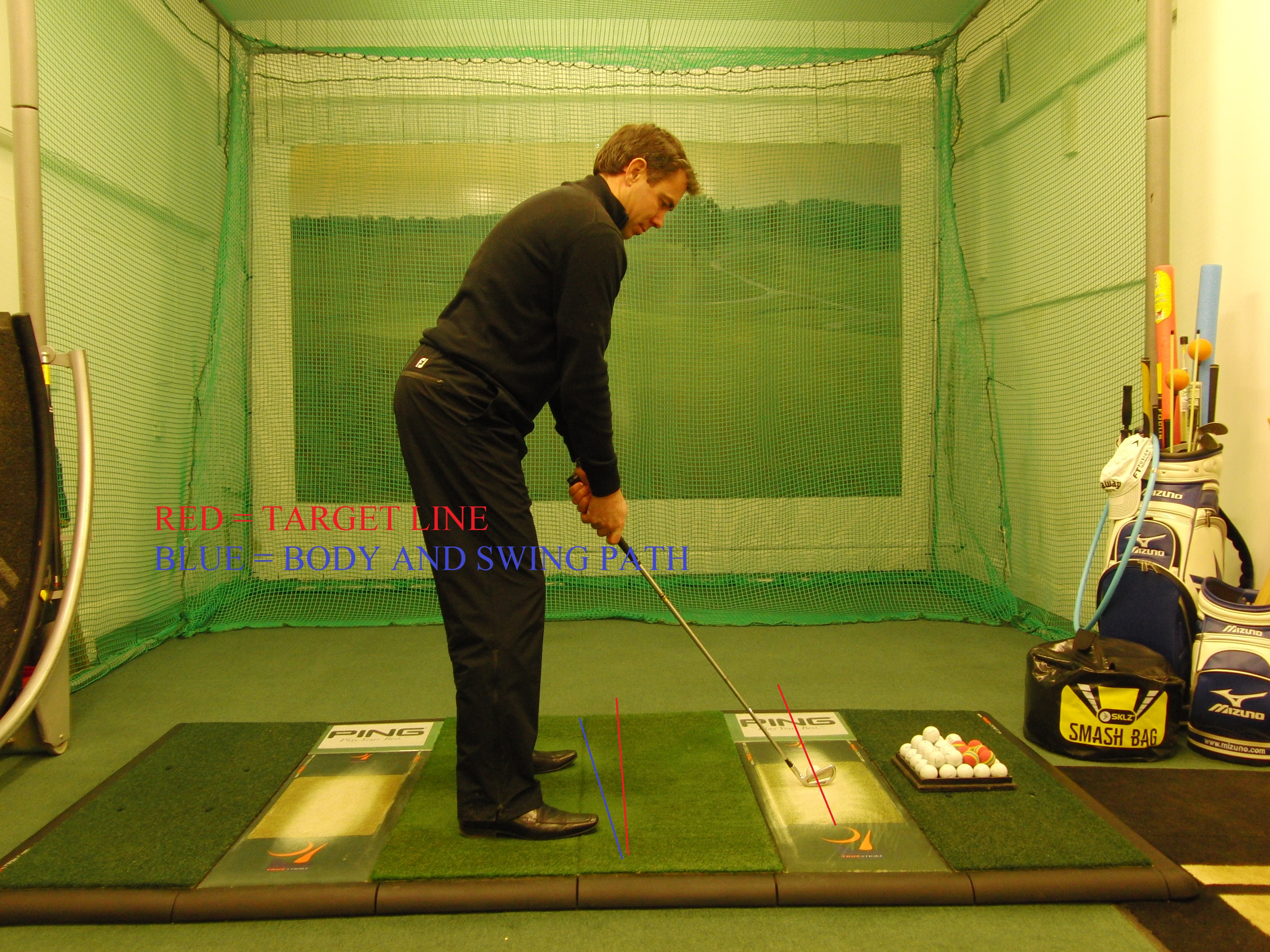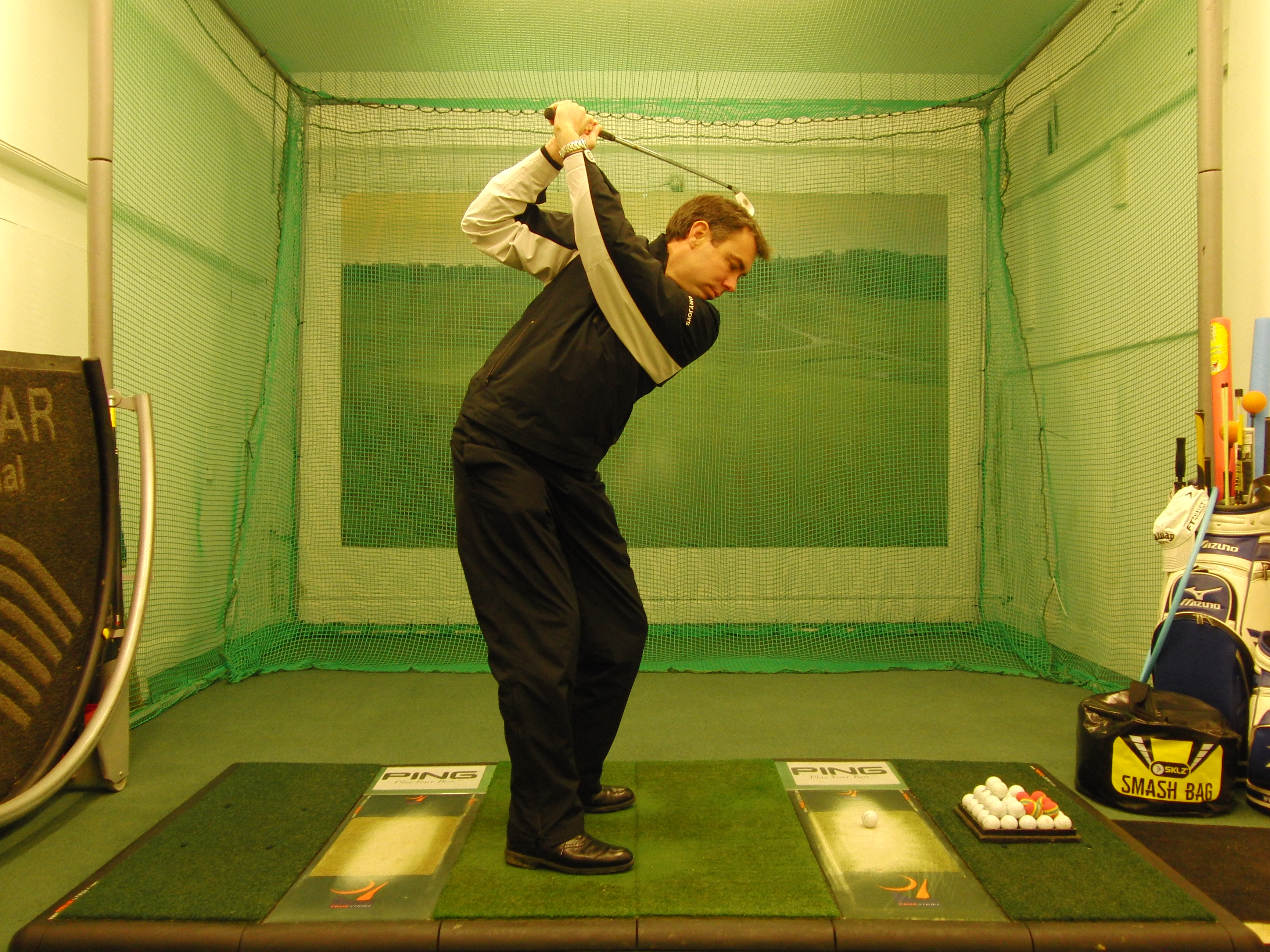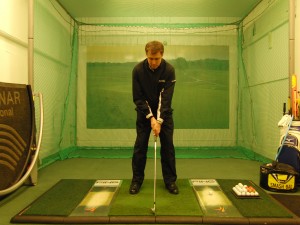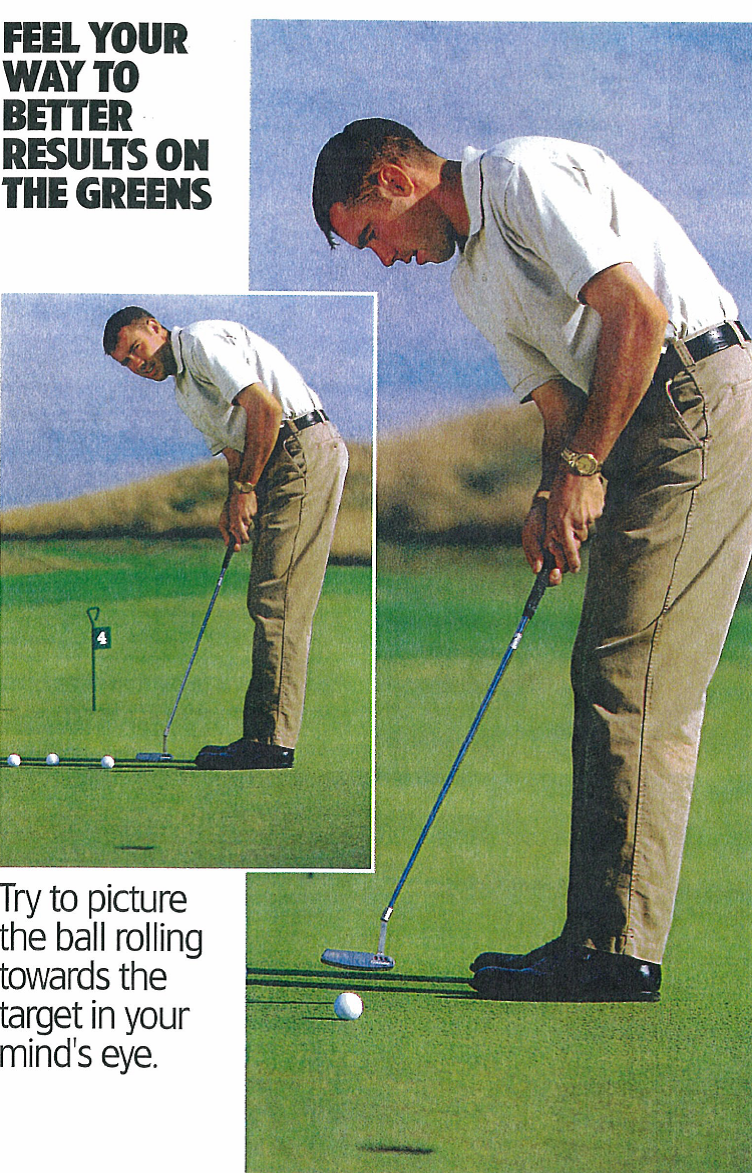Archive for the ‘General Golf Tips’ Category
Cure your Swing Plane and Slice
Curing an over the top swing plane leading to an in to out swing path and a SLICE!!
The “Reverse the loop” swing drill
I have a 5 iron in my hands for this drill but you could use any club, the most important thing is to angle the cane in the ground at the correct angle for this drill to work.
- Place an alignment cane on the ground parallel to your target line. This ensures that you stand parallel to your target line.
- Take another cane and push it into the ground slightly inside the target line and a club length behind the ball, the cane should be on an angle on roughly 60 degrees for a 5 iron (see above picture).
- The top of the cane should be running through your pelvis as you look at it.
- As you start your take away keep the club outside your hands and outside of the cane (see the above picture).
- Swing up to your normal full backswing position, ensuring you have a good full 90 degree shoulder turn.
I hope you enjoyed the article, any comments or Questions then please leave a comment below.
Download my free ebook packed with drills to stop your slice CLICK HERE
Until next time I wish you all the golfing success.
Mark
Mark Wood Golf Academy
Dale Hill hotel & golf club
East Sussex
Grip it Correctly for More Consistency
How to form the right Grip
The Grip is very important in the in the set up and golf swing as it is the only direct contact we have with the club. It gives us clubface control as well as leverage in the golf swing otherwise known as ‘lag’ which will help create more power.

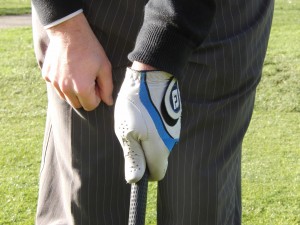
When placing the left hand onto the golf club make sure you have the grip sat down across the fingers so the fleshy pad sits on top of the grip. Always hold the club down an inch from the top of the handle as well.
Close your hand onto the grip making sure you keep a short left thumb as extending your left thumb down the grip will cause the left wrist to lock and can cause injury to the hand or wrist. It will also reduce the power within your swing and will also force the grip up into the palm of the left hand. Keep the ‘V’ of the left hand pointing up between your collar bone and right shoulder.
Linking the hands becomes a choice for you. You can either Overlap, interlook, intermesh or baseball (this is suited for juniors of a young age and ladies).
Placing your right hand onto the grip should be performed in the following way. Place the lifeline of your right hand onto the side of your left thumb and then close the right hand over onto the grip.
The inner part of the right forearm should be parallel to the target line and the ‘V’ of the right hand also pointing up in the same direction as the left hand ‘V’.
Keep the grip pressure light as a too tight a grip will rob you of clubhead speed and power.
I hope you enjoyed the article, any comments or Questions then please leave a comment below..
Until next time I wish you all the golfing success
Mark
Mark Wood Golf Academy
Dale Hill hotel & golf club
East Sussex
Tomi Putting Analysis
PUTTING LESSON WITH TOMI PUTT LAB
I had a client come to me for a putting lesson this week and he was getting really fed up because each week he had been out playing his partner from tee to green but once on the putting green it was a different story.
He was losing each week due to poor putting and as usual his playing partners were full of advice, “you’re aiming too far to the right with the putter head”, “you keeping looking up”, you’re decelerating”. The list went on!!
My client mainly missed putts to the right of the hole and hated short left to right putts.
So we used the Tomi Putting Analysis system that I use along with high speed video camera technology to find out just exactly what was going on during the putting stroke. The indoor putting green that we used was set up for a dead straight 8 foot putt.
Here are the pictures of my clients putting stroke before any changes were made.
The putter face was square to the line of putt as you can see from the numbers above, so that was not an issue.
The putter was returning to the ball at impact with a face pointing to the right of the target. In fact 4.6 and 3.4 degrees to the right of the hole and the path of the putter was 2.2 and 8.2 degrees to the right of the target line. Now we can see why he was missing his putts to the right; putter face open and path to the right = miss putts right
The putter head was opening up too much during the back stroke 10 and 9 degrees of rotation, which is a lot for an 8ft putt.
So after we viewed the Tomi Data and the high speed video analysis of his putting stroke we needed to change just one thing with my client and that was to reduce the amount that the putter face opened during the back stroke. Below are the results.
Putt head rotation reduced to just 4, 4, 4, 2, 2 opening in the back stroke.
Path of putter through impact improved to 1.2, 1.2, 1.0, -0.4, -0.4.
The putter head alignment at impact improved dramatically to just 0.6 open.
Now with the face of the putter opening just by 4, 4,4,2,2 degrees we had instantly improved his path of his putter during his putting stroke to and we also improved his putter face alignment at impact. This lead to twenty 8 foot putts holed in a row. All we did was to get him to weaken his left hand grip slightly by gripping it more in the palm and not in the fingers.
So next time you start missing a few putts, bear in mind what a session on the TOMI PUTT ANALYSIS software could do for you.
PS. My client played golf today and shot his best ever score of 76 and took just 31 putts instead of his average of 41..
I hope you enjoyed the article, any comments or Questions then please leave a comment below..
Until next time I wish you all the golfing success
Mark
Mark Wood Golf Academy
Dale Hill hotel & golf club
East Sussex
Tee Peg Drill – Improve Your Ball Striking
The “Tee Peg” Drill
This drill is a very popular amongst the top professionals to improve the path and ball striking purity. You can do this drill using any club, but start with a 6 iron.
- Place a row of four tee pegs just outside the toe end of the club about an inch apart. Then place one tee peg just outside the heel of the club and running up parallel to the shaft.
- Tee a ball up in between the front two tee pegs, see below picture.
Hit some shots with a full swing but half the pace of your normal swing so you can get a feel of the club going through the gap, not hitting the outside tee pegs. Once your confidence and swing path improves you can then get your swing back up to the normal tempo and rhythm.
Keep your arms and hands as relaxed as possible as tension is a big “feel” killer in a golf swing.
I hope you enjoyed the article, any comments or Questions then please leave a comment below..
Until next time I wish you all the golfing success
Mark
Mark Wood Golf Academy
Dale Hill hotel & golf club
East Sussex
Hit it Further
Lose the Tension for more Distance
Tension is a huge energy sapper in a golf swing, so when you set up to the ball make sure that your grip pressure is relaxed. The best way of doing this is to think about your forearms, if you keep these relaxed it is impossible to have tight tense wrists and a tight grip. Keep your chin held up and your neck muscles relaxed as this will also contribute in making a good athletic body turn which in turn leads to power. Remember your arms are the levers in a golf swing so keeping these relaxed adds to increased speed and power.
I hope you enjoyed the article, any comments or Questions then please leave a comment below..
Until next time I wish you all the golfing success
Mark
Mark Wood Golf Academy
Dale Hill hotel & golf club
East Sussex
Fairway Bunker Shots
THE FAIRWAY BUNKER SHOT
Escape the sand and play these shots like the pro’s…
Fairway bunker shots can be very intimidating for many golfers, but if you learn and practise the right techniques you will soon enjoy these shots. To start with, when playing out of fairway bunkers, it is important to take one to two clubs more than normal and make sure you have enough loft on the chosen club to clear the lip of the bunker. Set up normally with your feet slightly wriggled into the sand for stability and the ball positioned more toward the middle of your stance. Next step, which is very important, grip down slightly on the club for greater control. By also lifting your chin up a little from your chest gives you the feeling of standing “tall” and increases the chance of hitting the ball first, which if you are going to be successful at this shot, it’s a must. Making a swing at 70 percent of your normal speed will give you a great chance of hitting a clean, solid shot.
So, Hitting a shot from a fairway bunker poses no great problem if the ball has a good lie.
On long fairway bunker shots, Rescue (Hybrid) clubs or middle irons as well as 5 and 7 woods can be used with great confidence in this situation. Don’t try to overpower this shot. Restrict your golf swing a little via your body turn and swing easy and in balance.
With a bad lie in the bunker you need to re think and play more of a percentage shot, choose the club you are confident with, from say a 7 iron upwards. Take note of any other trouble and look to get the ball back into the fairway. Observe the course. Aim for a safe part of the fairway and just get your ball back into play.
I hope you enjoyed the article, any comments or Questions then please leave a comment below..
Until next time I wish you all the golfing success
Mark
Mark Wood Golf Academy
Dale Hill hotel & golf club
East Sussex
How To Hit The Pro Style Draw
How to Hit the Pro Style Draw
Many golfers all over the world would love to consistently hit a sweet, little DRAW. In my experience the major reason that most golfers fail with this particular shot is because they have a lack of understanding for how this shot is created. There has been a lot written and filmed on how to hit a draw, for example, your clubface has to be facing the target at address and at impact. That is completely incorrect, yes you will hit a right to left ball flight but the ball will always finish to the left of target. Quite often golfers are under the impression that the swing path governs the balls initial direction and the face puts the spin on the ball. This is unfortunately wrong information and will not produce the results of that sweet little draw you are after. We now have scientific evidence, from devices such as Trackman, Flightscope and other ball flight, swing path and clubface radars which track what is actually going on in the golf swing and gives us the DNA of what created that particular ball flight. This is hard plan facts, no guessing just pure scientific facts on what produces a draw. I am going to share with you how to hit the draw and what creates the right to left spin.
THE NEW WAY OF HITTING A DRAW
The first thing that we need to understand is the relationship of the clubface to the target line and the clubface relationship to the swing path.
The initial start direction of your shots is highly governed by the clubface at impact, basically to a large degree the ball will start where the clubface is pointing at impact. The swing path is what creates the curvature on the ball flight. Swing path tilts the spin axis of the ball.
So with this in mind we know that the clubface has to be open to the target line at address and impact but closed to the swing path. If we have the clubface 2 degrees open to the target line at address and impact the swing path needs to be 4 degrees right of the target line. The swing path is farther right than the clubface is aiming creating the “open to the target line but closed to the swing path” position.
This is what is going to create the ball to start right of target and then drawing back onto the target during its flight (right to left ball flight).
THE SET UP POSITION
How you set up and position the body at the address is very important as it key in hitting the draw.
- Your right foot needs to be a couple of inches back at the address and make sure you align your hips and shoulders on the same lines as the feet, this creates a closed stance to the target line.
- The body alignment will create the swing path that we need, the in to out swing path which will produce the draw ball flight.
- The backswing will feel flatter than normal which is great as it will make it a lot easier in creating the in to out swing path.
- Make sure you swing along your body alignment and try not to re-route the club to the outside in the downswing.
- The forearms should feel quite in the downswing and through impact as we need to remember the clubface needs to be closed to the swing path and open to the target line to produce that sweet little draw.
- The ball should start to the right of your intended target and then curve back onto the target during the ball flight.
I hope you enjoyed the article, any comments or Questions then please leave a comment below..
Until next time I wish you all the golfing success
Mark
Mark Wood Golf Academy
Dale Hill hotel & golf club
East Sussex
How to Hit a Fade
HOW TO HIT THE PRO STYLE FADE
Many golfers all over the world would love to consistently hit a sweet, little fade. In my experience the major reason that most golfers fail with this particular shot is because they have a lack of understanding for how this shot is created. There has been a lot written and filmed on how to hit a fade, for example, your clubface has to be facing the target at address and at impact. That is completely incorrect, yes you will hit a left to right ball flight but the ball will always finish to the right of target. Quite often golfers are under the impression that the swing path governs the balls initial direction and the face puts the spin on the ball. This is unfortunately wrong information and will not produce the results of that sweet little fade we are after. We now have scientific evidence, from devices such as Trackman, Flightscope and other ball flight, swing path and clubface radars which track what is actually going on in the golf swing and gives us the DNA of what created that particular ball flight. This is hard plan facts, no guessing just pure scientific facts on what produces a fade. I am going to share with you how to hit the fade and what creates the left to right spin.
THE NEW WAY OF HITTING A FADE
The first thing that we need to understand is the relationship of the clubface to the target line and the clubface relationship to the swing path.
The initial start direction of your shots is highly governed by the clubface at impact, basically to a large degree the ball will start where the clubface is pointing at impact. The swing path is what creates the curvature on the ball flight. Swing path tilts the spin axis of the ball.
So with this in mind we know that the clubface has to be closed to the target line at address and impact but open to the swing path. If we have the clubface 2 degrees closed to the target line at address and impact the swing path needs to be 4 degrees left of the target line. The swing path is farther left than the clubface is aiming creating the “closed to the target line but open to the swing path” position.
This is what is going to create the ball to start left of target and then fading back onto the target during its flight (left to right ball flight).
THE SET UP POSITION
How you set up and position the body at the address is very important as it key in hitting the fade.
- Your left foot needs to be a couple of inches back at the address and make sure you align your hips and shoulders on the same lines as the feet, this creates an open stance to the target line.
- The body alignment will create the swing path that we need, the out to in swing path which will produce the fade ball flight.
- The backswing will feel more upright than normal which is great as it will make it a lot easier in creating the out to in swing path.
- Make sure you swing along your body alignment and try not to re-route the club to the inside in the downswing.
- The forearms should feel quite in the downswing and through impact as we need to remember the clubface needs to be open to the swing path and closed to the target line to produce that sweet little fade.
- The ball should start to the left of your intended target and then curve back onto the target during the ball flight.
I hope you enjoyed the article, any comments or Questions then please leave a comment below..
Until next time I wish you all the golfing success
Mark
Mark Wood Golf Academy
Dale Hill hotel & golf club
East Sussex
Cupped Wrist, Across the Line, Flying Elbow
Cupped Wrist, Across the Line, Flying Elbow, Open Clubface
Hooks, Blocks, Push Cuts, Duffs etc….
A lot of golfers are searching for a great top of the backswing position and really struggle to find it and here is why.
The Picture above is a classic example of a flying elbow, cupped wrist and across the line position that I see amongst many golfers at my facility. These lead to poor shaped shots (blocks, hooks, push cuts etc…) and most certainly miss – hit shots from all over the clubface with a mixture of heavy and thinned golf shots. Sometimes there is a physical element that causes this position at the top, in which we do a quick flexibility test to see how mobile the arms and shoulders are, as the range of motion can be limited through injury or lack of flexibility. Some golfers can just have too much flexibility and just be completely unaware of where they are swinging up to in the backswing. Once we have established the clients ROM we can then proceed in the below exercise on making them aware of the feelings the correct position for them at the top of the backswing should feel like.
Grip the golf club with the Left Hand below the right for right handed golfers and the opposite for left handed golfers (right below left). Picture above.
Good position at the Top
Swinging up to the top of the backswing will feel very different, it will feel more restricted, the left wrist (for right handed golfers) will be much flatter the right elbow will be much more down and in more in front of the body. This will lead to the shaft being much more “in the slot” and the clubface will be square (leading edge matched up to the left arm). Your body will be much more in balance and engaged with the movements you are making. To start with, you will feel that you are doing less as there are fewer moving parts. Try to use a mirror when doing this exercise to link up the feel with the visual.
Your shot shape and distance will improve dramatically and so will the ball striking with the centred strikes off the clubface.
I hope you enjoyed the article, any comments or Questions then please leave a comment below..
Until next time I wish you all the golfing success
Mark
Mark Wood Golf Academy
Dale Hill hotel & golf club
East Sussex
MIND OVER MECHANICS
MIND OVER MECHANICS
THE FAULT
Many golfers struggle on the greens because they often make what is in reality a fairly simple physical action, much more difficult, mainly through thinking too much about the mechanical action of their putting stroke.
When the physical aspects of putting take over it can often lead to a loss of feel for your putts and good feel is essential, both for your stroke and also when it comes to judgement of distance.
So if you are experiencing problems with this aspect of your game try this simple drill that will help get that essential feel back into your putting stroke.
THE CURE
Next time you have a few minutes to spare prior to a round of golf or even during a practise session, find a quiet spot on the putting green and try this simple drill. Take up your normal putting stance, but before you actually hit the ball, take several practice strokes looking directly towards the hole instead of down at the ball.
Try to visualise the length and pace of stroke that would be required to roll the ball the required distance. And if possible, try also to picture the ball rolling towards the target on the given line and into the hole in your mind’s eye.
As you swing the putter gently back and through, you should start to become much more aware of the weight of the putter head and the pace of your stroke. You will soon discover that your natural feel for distance and pace will become the dominant factors in your putting stroke, rather than the physical mechanics of the stroke.
Then when you get out onto the golf course, try to introduce the same “feel” drill into your pre – shot putting routine.
I hope you enjoyed the article, any comments or Questions then please leave a comment below..
Until next time I wish you all the golfing success
Mark
Mark Wood Golf Academy
Dale Hill hotel & golf club
East Sussex




